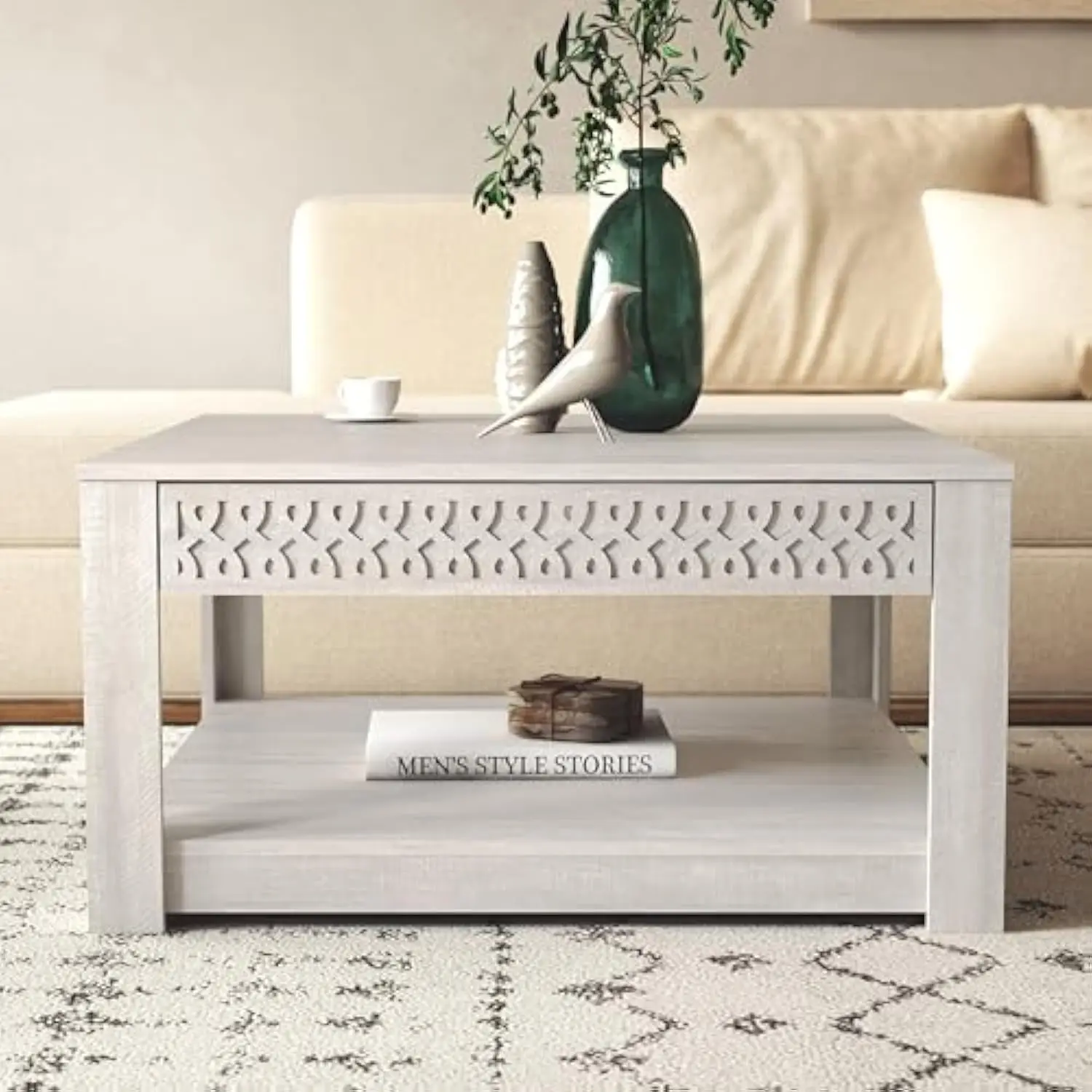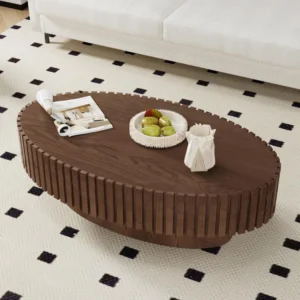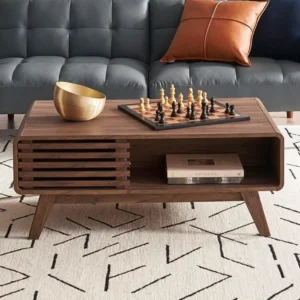Understanding Mid-Century Lift-Top Coffee Tables: Timeless Design Meets Modern Functionality
The mid-century lift-top coffee table represents a perfect marriage of form and function—blending the clean, organic aesthetic of classic mid-century design with innovative lift-top functionality that serves modern living needs. These distinctive pieces capture the essence of mid-century modern principles—simple lines, functional design, and natural materials—while adding a contemporary twist that makes them incredibly practical for today’s homes.
Mid-century modern design emerged as an influential movement characterized by sleek silhouettes, tapered legs, and a focus on honest materials. Its enduring popularity stems from its timeless appeal and ability to complement various interior styles. When combined with lift-top functionality, these classic designs transform into versatile furniture pieces that address the evolving needs of contemporary living spaces.
What makes these tables particularly appealing in modern homes is their dual nature. At first glance, they present as stylish centerpieces with authentic mid-century character. Yet with a simple mechanism, they convert into functional workspaces, dining surfaces, or activity centers—perfect for smaller apartments, multifunctional rooms, or anyone seeking furniture that works as hard as it looks good.
The resurgence of mid-century design in contemporary interiors has coincided with a growing appreciation for functional lift-top coffee tables that solve practical problems while maintaining aesthetic integrity. As living spaces become more compact and multifunctional, these hybrid pieces offer elegant solutions without compromising on style or craftsmanship.
In this guide, we’ll explore the distinctive design elements of mid-century modern lift-top coffee tables, examine their materials and mechanisms, and provide practical advice for selecting, styling, and maintaining these versatile pieces.
Signature Elements of Mid-Century Modern Coffee Table Design
Mid-century modern coffee tables are instantly recognizable for their distinctive design language that emerged as a response to changing lifestyles and manufacturing capabilities. Understanding these signature elements helps in identifying authentic mid-century design and appreciating its enduring appeal.
Clean Lines and Organic Forms
The hallmark of mid-century design is its emphasis on clean, uncluttered lines that create visual harmony. These pieces typically feature:
- Streamlined profiles with minimal ornamentation
- A perfect balance between geometric precision and organic softness
- Gentle curves that complement straight edges
- An overall sense of visual lightness and airiness
Mid-century tables often incorporate organic shapes inspired by nature alongside more geometric forms. This interplay creates pieces that feel both structured and approachable, with softened corners and flowing transitions between elements.
Iconic Leg Designs
Perhaps no feature is more distinctive of mid-century tables than their characteristic leg designs:
- Tapered legs that gradually narrow toward the floor, creating a sense of lightness
- Splayed legs (often called “peg legs”) that angle outward from the table’s center
- Hairpin legs made from bent metal rods that provide strength with minimal visual weight
- Sculptural wooden legs with organic, carved profiles
These leg styles elevate the table from the floor, creating negative space beneath that enhances the feeling of openness in a room. This “floating” quality is fundamental to the mid-century aesthetic and contributes to its continued popularity in contemporary interiors.
Form Following Function
The mid-century design philosophy emphasized that beauty should emerge naturally from an object’s purpose rather than from unnecessary decoration. This principle is evident in the thoughtful proportions, balanced weight distribution, and emphasis on usability that characterizes black mid-century coffee tables and their counterparts in other finishes.
The resulting designs feel intentional and purposeful—where every curve, angle, and joint serves both practical and aesthetic purposes. This honest approach to design creates pieces that remain relevant and appealing across decades, transcending passing trends.
The Material World: Woods and Mixed Media in Mid-Century Tables
Materials play a crucial role in defining authentic mid-century coffee tables, with an emphasis on natural elements and honest expression of texture and grain.
Signature Woods
The most distinctive mid-century tables feature high-quality hardwoods selected for their beauty and durability:
- Walnut: Prized for its rich, chocolate-brown tones and striking grain patterns
- Teak: Valued for its warm honey color, natural oils, and exceptional durability
- Oak: Appreciated for its strong grain pattern and light to medium tone
- Rubberwood: Offers sustainable sourcing with a straight grain and light color
- Mango wood: Provides unique character with varied grain patterns and warm hues
These woods are typically finished to highlight their natural beauty rather than disguise it. Matte or satin finishes that allow the wood’s character to shine through are preferred over high-gloss treatments that might mask the material’s inherent qualities.
Mixed Material Integration
Many mid-century tables incorporate additional materials that complement the primary wood construction:
- Metal accents, particularly in tapered legs, frames, or decorative elements
- Glass inserts or tops that create visual lightness
- Laminate surfaces in solid colors or patterns (more common in casual or budget-friendly designs)
The integration of these materials follows the principle of honest expression—each material serves a purpose and remains true to its nature rather than imitating something else. This approach creates visual interest through contrast while maintaining design cohesion.
Solid wood coffee tables from this design period showcase the craftsman’s respect for materials. Wood grain is often aligned thoughtfully, joints are precisely executed, and the natural beauty of the material becomes an integral part of the design statement.
Lift-Top Mechanics: How These Transformative Tables Work
The ingenious lift-top mechanism transforms a conventional coffee table into a multi-functional piece that adapts to different needs throughout the day. Understanding how these mechanisms work helps in selecting a quality table that will provide reliable service.
Mechanism Types
Most lift-top coffee tables employ one of two primary mechanism types:
Spring-Loaded Systems:
– Use metal springs to assist in lifting and lowering the tabletop
– Require some manual force to initiate movement
– Typically provide a lighter, snappier action
– Often found in more affordable models
Hydraulic/Gas Lift Systems:
– Utilize gas pistons similar to those used in office chairs
– Offer smooth, controlled movement with minimal effort
– Provide better support for heavier items on the raised surface
– Generally last longer with fewer maintenance issues
– More common in premium table designs
Both systems are designed to move the top surface not just upward but also forward, allowing the raised surface to extend over your lap when seated on a sofa or chair. This forward movement is what makes these tables uniquely functional as workspaces or dining surfaces.
Engineering Considerations
Quality lift-top tables incorporate thoughtful engineering that ensures stability and safety:
- Counterbalanced mechanisms that prevent sudden drops or slams
- Locking mechanisms that secure the top in raised position
- Reinforced attachment points that distribute weight properly
- Guided tracks that ensure smooth, consistent movement
- Sturdy construction that prevents wobbling when the top is extended
The weight capacity of the raised surface is a key consideration, particularly if you plan to use the table for laptops, meals, or other substantial items. Premium tables typically support 15-25 pounds on the raised portion without compromising stability.
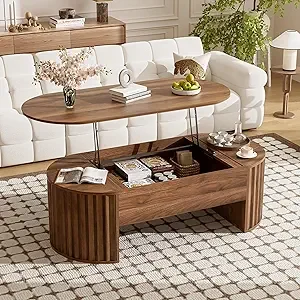
The integration of these mechanical elements into the clean, minimalist mid-century aesthetic requires careful design. The best everyday lift-top coffee tables conceal their mechanisms when closed, maintaining the pure lines of mid-century design while adding functionality that wasn’t part of the original design movement.
Versatility Unleashed: Practical Benefits of Lift-Top Functionality
The marriage of mid-century design with lift-top functionality creates pieces that seamlessly adapt to our modern, multifunctional living needs. These tables offer practical benefits that enhance everyday life in several key ways.
Ergonomic Workspace
One of the most valuable features of a lift-top table is its ability to transform into an impromptu desk:
- Raises your laptop or tablet to a comfortable typing height, reducing neck and wrist strain
- Creates a proper workspace without requiring a dedicated home office
- Provides a stable surface for writing, drawing, or other detail work
- Allows for productive work sessions while remaining in comfortable seating
This adaptability is especially valuable in smaller homes or for those who work remotely part-time but don’t have space for a permanent desk setup.
Convenient Dining Solution
The elevated surface creates dining possibilities that a standard coffee table can’t match:
- Perfect height for comfortable eating while seated on a sofa or chair
- Eliminates the need to hunch over a low coffee table during meals
- Ideal for casual dinners, TV snacks, or entertaining
- Reduces the need for additional furniture in compact living spaces
This dining functionality makes these tables particularly valuable for studio apartments or open-concept living areas where space-saving solutions are essential.
When comparing lift-top versus fixed-top coffee tables, the added versatility becomes apparent through everyday use scenarios. The ability to adjust height transforms how you interact with the table throughout different activities and times of day.
Activity-Friendly Design
Beyond work and dining, lift-top tables accommodate various leisure activities:
- Board games and puzzles at a comfortable height
- Crafting projects with supplies kept organized
- Reading with books propped at an ideal angle
- Children’s activities with better access and visibility
This adaptability makes these tables excellent centerpieces for family living areas, encouraging interaction while maintaining the sophisticated mid-century aesthetic when not in active use.
Hidden and Open Storage Solutions: Keeping Clutter at Bay
Storage features are one of the most practical benefits of mid-century lift-top coffee tables, offering clever solutions for organizing living room essentials while maintaining a clean aesthetic.
Concealed Compartments
The space beneath the lifting top typically offers substantial hidden storage:
- Single large compartments ideal for throw blankets, magazines, or board games
- Divided sections that help organize smaller items like remotes, coasters, and tech accessories
- Felt-lined areas in premium models to protect delicate items
- Concealed storage that preserves the clean lines of mid-century design
This hidden storage is particularly valuable because it’s accessible from a seated position—simply lift the top to retrieve items without getting up from the sofa.
Additional Storage Features
Many lift-top designs incorporate supplementary storage elements:
- Open shelving beneath the table for items you want visible or easily accessible
- Side drawers for organized storage of smaller items
- Magazine racks or slots built into lower sections
- Divided compartments for different categories of items
These thoughtfully designed storage solutions help revolutionize your living room by reducing visual clutter while keeping frequently used items close at hand. The best designs maintain the lightweight, airy feeling of mid-century design despite incorporating substantial storage capacity.
Space-Saving Benefits
For apartment dwellers or those with compact living areas, the storage efficiency of these tables provides significant advantages:
- Eliminates the need for additional storage furniture in tight spaces
- Keeps essentials organized and accessible rather than scattered across surfaces
- Allows for quick cleanup by providing an immediate place to tuck away items
- Combines the roles of coffee table, desk, and storage unit in one footprint
The clever integration of storage within the table’s silhouette demonstrates how mid-century design principles can be adapted to address contemporary living challenges without compromising aesthetic integrity.
Sizing and Space Planning: Finding the Perfect Dimensions
Selecting the right size for your mid-century lift-top coffee table ensures it will function properly in your space while maintaining proper proportion with your other furniture.
Standard Dimensions
Mid-century coffee tables typically fall within certain dimensional ranges:
- Rectangular tables: 42-54 inches long, 20-28 inches wide
- Square tables: 30-40 inches on each side
- Heights: 16-19 inches when closed (standard mid-century height tends toward the lower end)
- Lift mechanism raises the top an additional 6-10 inches
Remember that the lift mechanism requires clearance not just above but also in front of the table, as the top typically moves forward as it rises.
Proportional Relationships
The table should be in harmony with surrounding furniture:
- Length ideally between 1/2 and 2/3 the length of your sofa
- Height when closed slightly lower than or equal to sofa seat height
- Width allowing for 12-18 inches between table and seating for comfortable leg room
- Scale in balance with other living room pieces (neither too dominant nor too diminutive)
Lift-top coffee tables for small spaces often feature more compact footprints or space-saving shapes like rounds or ovals that facilitate movement in tight areas.
Clearance Considerations
The transforming nature of lift-top tables requires additional planning:
- Allow 16-20 inches of clearance in front of the sofa for the extended top
- Ensure overhead clearance for the raised position (particularly if under shelving)
- Consider traffic patterns when the table is in both closed and opened positions
- Plan for accessibility from multiple seating positions if the space will be used by several people
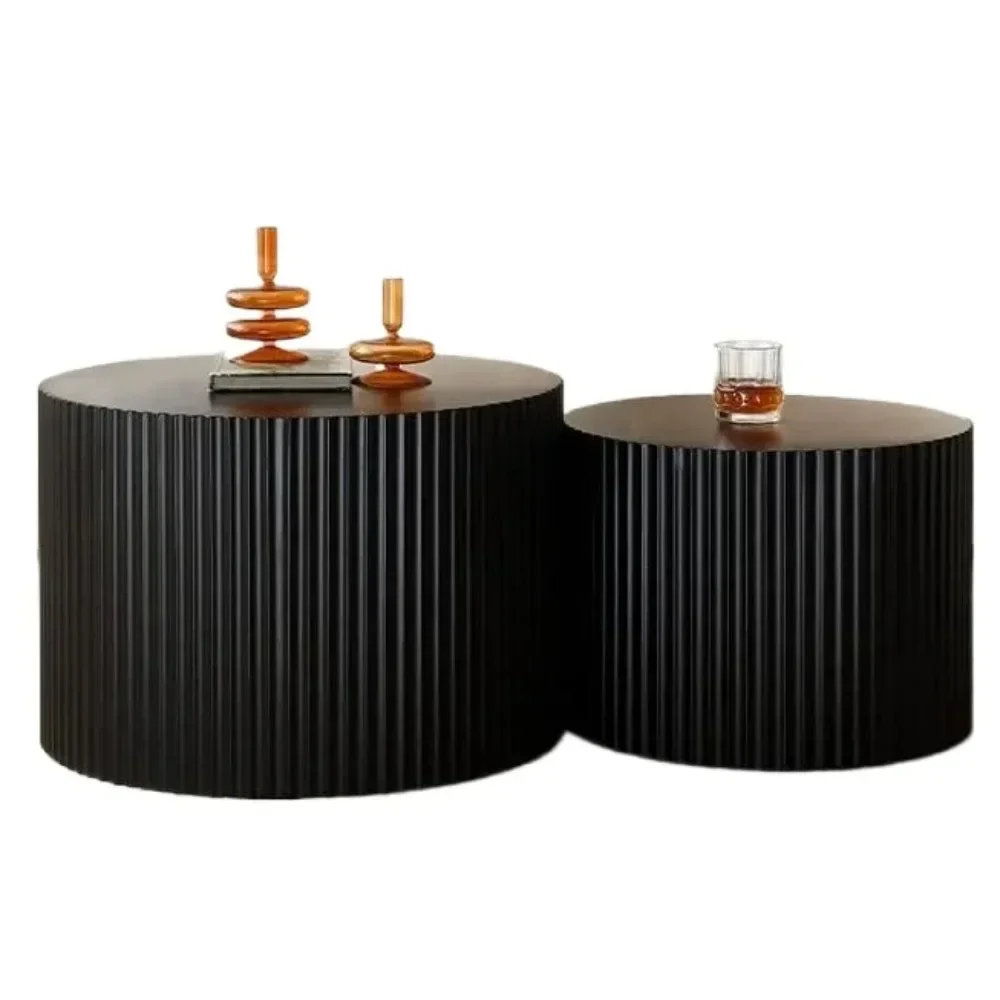
Material Quality and Construction: What to Look For
The longevity and performance of a mid-century lift-top coffee table depend largely on its construction quality. Knowing what to look for helps ensure you’re investing in a piece that will stand the test of time.
Wood Quality Indicators
When evaluating wood construction, pay attention to:
- Solid hardwood vs. engineered wood with veneers (solid wood offers superior durability but quality veneers can provide excellent grain patterns)
- Consistent grain matching across surfaces
- Smooth, even finishes without roughness or inconsistencies
- Wood that has been properly dried to prevent future warping or cracking
- Edge treatments that protect vulnerable corners
- Natural color variations that indicate genuine wood rather than imitations
Walnut coffee tables are particularly prized in mid-century design for their rich color and distinctive grain, but each wood type has its own quality markers.
Construction Methods
Quality construction reveals itself in several ways:
- Joinery techniques: Look for mortise-and-tenon, dovetail, or finger joints rather than just screws and glue
- Corner braces that reinforce the table’s structure
- Smooth-operating drawers with proper glides (if included)
- Solid back panels rather than flimsy materials
- Even weight distribution that prevents wobbling
- Consistent gaps between moving parts
Hardware and Components
The mechanical elements deserve special attention:
- Smooth-operating lift mechanisms without catching or sticking
- Solid metal hardware rather than plastic components
- Reinforced attachment points for the lift mechanism
- Gas pistons from recognized manufacturers (if hydraulic)
- Even movement throughout the lifting range
- Soft-close features in premium models
These quality indicators not only affect functionality but also determine how well the table will maintain its appearance and performance over years of daily use.
Budget Considerations: Balancing Quality, Features, and Price
Mid-century lift-top coffee tables span a wide price range, reflecting variations in materials, craftsmanship, and mechanism quality. Understanding these price factors helps set realistic expectations and make informed decisions.
Price Range Overview
These tables typically fall into three general price categories:
- Entry-level ($150-350): Often feature engineered wood with veneers, simpler lift mechanisms, and basic storage
- Mid-range ($350-600): Offer better wood quality, more reliable mechanisms, and enhanced storage options
- Premium ($600+): Feature solid hardwoods, precision craftsmanship, superior lift mechanisms, and refined details
While budget constraints are real, it’s worth considering the table as a long-term investment rather than a temporary solution, particularly given its central role in daily living.
Value Considerations
When evaluating price against features, prioritize:
- Mechanism quality over decorative elements (a beautiful table with a failing mechanism quickly becomes frustrating)
- Structural integrity over size (a smaller, well-built table serves better than a larger, poorly constructed one)
- Material authenticity that aligns with mid-century principles
- Construction methods that ensure longevity
- Versatility that meets your specific living needs
Remember that lift-top tables combine multiple furniture functions (table, desk, storage), potentially making them more economical than purchasing separate pieces for each function.
Mid-Century Modern Solid Wood Coffee Tables, Mid-Century Modern Teak Coffee Tables
$879.95 Select options This product has multiple variants. The options may be chosen on the product pageMid-Century Modern Danish Coffee Tables, Mid-Century Modern Oval Coffee Tables, Mid-Century Modern Solid Wood Coffee Tables
$390.05 Select options This product has multiple variants. The options may be chosen on the product pageMid-Century Modern Coffee & End Table Sets, Mid-Century Modern Coffee Table Sets, Mid-Century Modern Oval Coffee Tables
Price range: $257.48 through $331.04 Select options This product has multiple variants. The options may be chosen on the product pageMid-Century Modern Lift Top Coffee Tables, Mid-Century Modern Square Coffee Tables
$454.73 Select options This product has multiple variants. The options may be chosen on the product pageMid-Century Modern Oval Coffee Tables, Mid-Century Modern Solid Wood Coffee Tables
$679.56 Select options This product has multiple variants. The options may be chosen on the product pageMid-Century Modern Solid Wood Coffee Tables, Mid-Century Modern Walnut Coffee Tables
$501.53 Select options This product has multiple variants. The options may be chosen on the product page
At Hearth Forms, each table is evaluated against strict criteria for both design authenticity and functional performance, ensuring quality at every price point and helping customers make confident selections based on their individual needs and budget.
Styling Your Mid-Century Lift-Top Coffee Table: Design Integration Tips
Incorporating a mid-century lift-top coffee table into your space involves thoughtful consideration of both aesthetic harmony and practical functionality. These styling approaches help achieve a cohesive look while maximizing the table’s versatility.
Complementary Furniture Pairings
For a harmonious mid-century look:
- Pair with sofas featuring clean lines and tapered legs for design continuity
- Add side tables in complementary wood tones (exact matching isn’t necessary in mid-century design)
- Consider accent chairs with similar design language but different materials
- Use area rugs with geometric patterns or subtle textures to anchor the arrangement
Coffee and end table sets offer coordinated options that take the guesswork out of creating a cohesive look while maintaining the distinctive mid-century modern character.
Tabletop Styling Approaches
When the table is in its closed position:
- Follow the mid-century principle of “less is more” with selective, purposeful accessories
- Create balanced asymmetry rather than perfect symmetry for visual interest
- Incorporate elements with varying heights (short stacks of books, low plants, sculptural objects)
- Use trays to group smaller items and make them easily removable when activating the lift function
- Include natural elements like wood, ceramics, and plants that complement the mid-century organic aesthetic
Functional Styling Considerations
To maintain both style and practicality:
- Keep the tabletop lightly styled for easy transition to lift-top functionality
- Store frequently used items in the hidden compartment for quick access
- Consider dual-purpose decorative items that serve practical functions (attractive coasters, decorative boxes for storage)
- Arrange seating to allow comfortable access to both the standard and raised positions
- Create clear zones around the table for its extended footprint when raised

The beauty of these versatile pieces is that they can shift from stylish centerpieces to functional workspaces throughout the day while maintaining their design integrity.
Care and Maintenance: Preserving Beauty and Function
Proper care ensures your mid-century lift-top coffee table remains beautiful and functional for years to come. Both the natural materials and mechanical components require specific maintenance approaches.
Wood Surface Care
To maintain the beauty of wood components:
- Dust regularly with a soft, slightly damp cloth, following the direction of the wood grain
- Clean spills immediately to prevent staining or water damage
- Use coasters under beverages and felt pads under objects that might scratch
- Apply furniture polish or conditioner specifically formulated for your wood type every 3-6 months
- Keep the table out of direct sunlight to prevent fading and drying
- Maintain consistent humidity levels to prevent wood expansion and contraction
Mechanism Maintenance
To ensure smooth operation of the lift mechanism:
- Keep the tracks and hinges clean and free from dust and debris
- Apply a small amount of silicone-based lubricant to moving parts if squeaking occurs
- Avoid overloading the raised surface beyond its weight capacity
- Lower the top gently rather than allowing it to drop
- Check and tighten any visible screws periodically as normal use may loosen them
- Address any resistance or unusual sounds immediately before they lead to more significant problems
Preventative Measures
Simple habits that extend your table’s lifespan:
- Use felt or cork pads on the table feet to protect your flooring and reduce strain on the table’s joints
- Move the table by lifting rather than dragging to maintain structural integrity
- Teach household members proper operation of the lift mechanism
- Consider furniture covers if the table will be in storage or unused for extended periods
- Apply protective treatments recommended by the manufacturer when appropriate
The design benefits of round mid-century tables often include easier maintenance due to the absence of corners that can be bumped or damaged, though the principles of care remain consistent across all shapes.
FAQ: Common Questions About Mid-Century Lift-Top Coffee Tables
How stable is the table when the lift-top is raised?
Quality mid-century lift-top coffee tables are engineered for stability in both positions. The better models distribute weight properly and use counterbalanced mechanisms to prevent tipping. While they’re stable enough for typical use like laptops and meals, avoid leaning heavily on the extended edge or placing extremely heavy items on the raised portion.
What’s the typical weight capacity for the raised surface?
Most lift-top mechanisms are designed to support between 15-25 pounds on the raised portion, which is sufficient for laptops, books, dinner plates, and similar items. Premium models may offer higher capacities. The table’s specifications should clearly state this limit, and exceeding it could damage the mechanism over time.
Are these tables difficult to assemble?
Assembly complexity varies by model. Many require basic assembly of the legs and lift mechanism, typically taking 30-60 minutes with standard household tools. Premium solid wood versions often arrive with the mechanism pre-installed, requiring only leg attachment. Always follow the manufacturer’s instructions carefully, particularly for proper alignment of moving parts.
Will a mid-century table look out of place if my other furniture isn’t mid-century?
Mid-century design is remarkably versatile and pairs well with many styles. The clean lines and natural materials complement contemporary, Scandinavian, and industrial designs particularly well. Even in more traditional spaces, a mid-century piece can serve as an intentional contrast. Focus on coordinating wood tones and proportions rather than matching exact styles.
How long do the lift mechanisms typically last?
With proper care, quality lift mechanisms should function well for many years. Gas-lift systems generally outlast spring mechanisms, often lasting 7-10 years of regular use before potentially needing adjustment or replacement. Proper operation (not forcing movement or exceeding weight limits) significantly extends mechanism lifespan.
Can these tables be used on carpet or uneven floors?
Yes, though stability is best on firm, level surfaces. On carpet, consider using furniture coasters to distribute weight more evenly and prevent wobbling. For slightly uneven floors, adjustable feet on some models allow for leveling. The lifting function works on any surface, but stability in the raised position may be reduced on very soft or uneven flooring.
Multi-purpose lift-top tables offer additional functionality beyond what’s covered here, and specific features may vary between manufacturers and models.
Why Choose a Mid-Century Lift-Top Coffee Table? The Perfect Balance
Mid-century lift-top coffee tables represent a thoughtful solution for modern living—they honor the clean aesthetic and quality craftsmanship of classic design while incorporating practical innovations that address contemporary needs. This combination makes them uniquely valuable pieces in today’s homes.
The enduring appeal of mid-century design comes from its emphasis on honest materials, functional beauty, and human-centered proportions. These principles create furniture that feels both timeless and fresh, avoiding the dated quality that affects more trend-driven pieces. By incorporating lift-top functionality, these tables extend that human-centered approach into new dimensions of usability.
In increasingly versatile living spaces where rooms serve multiple functions, furniture that adapts is invaluable. These tables transition effortlessly from decorative surfaces to workspaces, dining tables, or activity centers—all while maintaining their aesthetic integrity. The hidden storage further enhances their practical value, helping maintain the uncluttered simplicity that mid-century design celebrates.
When selecting such a table, prioritize quality construction, mechanism reliability, and proportions appropriate to your space. Consider it not just as a purchase but as an investment in both beautiful design and daily functionality that will serve you for years to come. The perfect mid-century lift-top coffee table doesn’t ask you to choose between style and function—it delivers both in perfect harmony.

